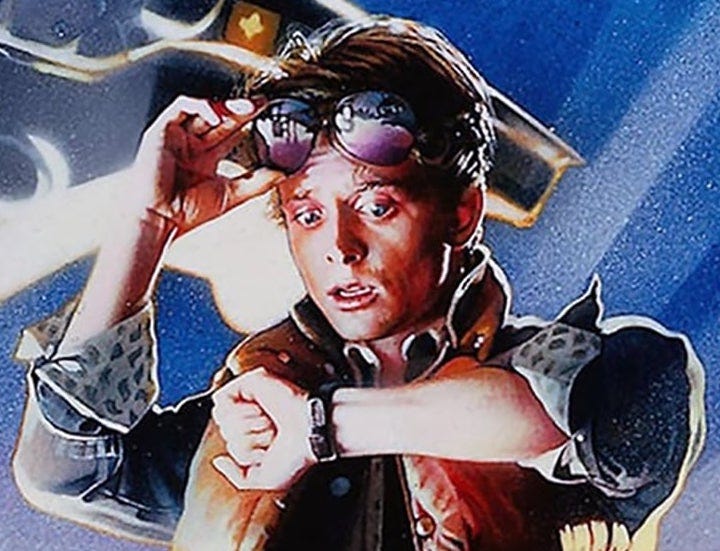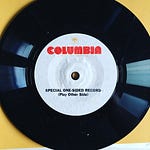This month, I’m relaunching the audio edition of my newsletter. This is a weekly podcast in which I read an adapted version of the newsletter that includes additional sound and music performed by…me. This time around, the audio edition will be available only to paying subscribers. You can sign up at any level to get the podcast. To celebrate the return of the audio edition, I’m bringing back an episode from last year, all about headphones.
Think of the last time you went out. Were most people you passed wearing headphones, earbuds, or something similar?
This might seem like an unsurprising realization. The price and availability of smartphones has dropped steadily. The same is true for headphones. For years, the two were even packaged together. But as obvious as the fact is, the speed at which this has happened is remarkable1. It's happened so fast, I wonder if we've started to absorb what it means for so many people to suddenly change the way they use one of their senses.
For the first half of the 20th century, headphones were a technical tool. They were for switchboard operators and anyone monitoring ship-to-shore signals. Some hi-fi obsessives might have had a pair at home, but anyone out and about with headphones on probably also had a metal detector. The first portable transistor radios changed this. They came along in 1954. A search through newspaper, book, and magazine archives shows that mentions of the term "earphones" exploded in the late '50s. In the newspaper archives, a lot of these mentions are in advertisements2.
This changed again in the 1980s. The path of mobile sound changed, too…Because of the Walkman.
The Walkman popularized the term "headphones." There's a spike in the use of the term in print beginning in 1980. And what it meant to wear headphones changed, too. Wearing them didn't make you look like a United Nations interpreter or submarine radar technician. In the U.S., headphones became a symbol of youth, particularly slacker youth. In Back to the Future, Marty McFly keeps them on his neck like jewelry.


This cultural shorthand was so ubiquitous, it's now a signifier of the decade. The backstory of one character in Guardians of the Galaxy is represented by a Walkman with headphones.
Headphones became a status symbol. They said you had a strong enough love of music to own a Walkman, and enough money to buy one. As the number of portable audio players grew, so did the potential for headphones as signifiers or advertisements.
In the early 2000s, white earbuds were the mark of an iPod. And having an iPod in those years said a lot about you. It was a marker of a mainstream idea of cool. Apple used it as the basis of their ads for four years. TV commercials and billboards showed people dancing with their iPods. The dancers were framed as silhouettes against a bright background, making the white earbud cable the center of attention. The images were so iconic, Apple has brought the campaign back, this time focusing on wireless AirPods3.
The revolution of wireless earbuds, beyond the convenience, is the need to almost never remove them—in part because we’re wearing them all the time, and in part because there’s no headband or cable that allows us to easily remove and wear them. The other day, while we did separate chores, Linda and I each listened to our own devices. When we stopped to talk, we didn't remove our earbuds. We just paused whatever we were listening to. If you set up a digital avatar on an Apple device, you can give the caricature of yourself a pair of AirPods, just like you would give it earrings or a jaunty cap4.
All headphone wearers have one thing in common—they have a secret. The secret is what is (or isn’t) coming through the headphones. This idea is laid out in The Walkman Effect, a fascinating paper by Shuhei Hosokawa published in 1984. “The walkman holder…neither refuses communication nor is isolated from reality, but continues enunciating the existence of his secret in this simple way,” Hosokawa writes.
The Walkman didn’t create this world of private listening, it just expanded it. Before the Walkman, the car was a private space where you could listen to whatever you wanted, provided it was on the radio or a cassette5. The Walkman and its attached headphones made this possible anywhere, no car or road required. The Walkman Effect is the sense of control headphone wearers have over their environment. The sounds of the city are random. They can become musical in their way. But to have music at one's command is to control the soundtrack of life, rather than let strangers or nature control it.
This was the final step in creating what Hosokawa calls “the mobility of the self.” What we choose to listen to is part of who we are. And headphones let us take that part of ourselves wherever we go. Our soundtracks our selves.
The Walkman Effect begins with a dismissal of the expected hand-wringing associated with headphones. The author describes an average person who is asked whether Walkman users "are human or not; whether they are losing contact with reality." The respondent laughs off these questions as old-fashioned, then looks forward to the day when "you will have every kind of film on video at home, every kind of classical music on only one tape." This is the new era of autonomy.
We have this now, and then some. Our listening options are no longer limited to the radio shows that are on at the time, the tapes we have, or the MP3s we can move to our iPods through a Firewire cable. We can listen to anything—a politics podcast, a favorite song, a new release (or the audio edition of this newsletter). But our choices of what to listen to seem less important now than our choice of what to do while we listen.
The mobile self is always moving. That is, it’s always doing something else. Hosokawa points out that listening on the go is really listening and walking or listening and driving. We were always free to do other things while playing records or the radio at home. And this is great. Music makes so many things better. Being able to listen in more places, during more tasks, is wonderful. But there are downsides. Hosokawa writes that being mobile "enables our musical listening to be more occasional, more incidental, more contingent.”
Open your streaming app and you’ll find music is now largely organized by incidents and contingencies. There are playlists for relaxing, studying, cooking, working out. These are put together by professionals or assembled by algorithms. We choose what to listen to based on the activity we do while listening, and we leave the specifics of that listening up to a curator or a computer. We’ve attained the autonomy the Walkman promised, and we readily give it up.
There’s a fine line between soundtrack and background music. It’s so fine, it’s hard to know when we’ve crossed it.
After work a few weeks ago, I decided to take a walk and grab a beer. Approaching a restaurant, I switched my sunglasses for my regular glasses, put my earbuds in their case (as comfortable as I am having conversations in headphones on the street or at home, I still try to keep them off for transactions like this), and put on my facemask. Walking out to sit on the patio, I set down my drink and changed my face again. I swapped my glasses, removed my mask, and popped my earbuds back in. I hit play on my music. I felt like myself.
I realize I'm dating myself by calling everything we use for personal recreational listening headphones. Earbuds is the more accurate term, and one that's used increasingly often. I imagine that in a decade, "headphones" will be used only to refer to over-the-ear models. Because these are so often sold as high-end or fashionable, the word might take on the same connotations. Earbuds are what you use for phone calls. Headphones are what connoisseurs use for music.
Surprisingly, a lot of the ads are for televisions that feature earphone jacks.
These are called silhouette ads, but you can see some details of the dancers, all of which are rich with fashionable meaning—the checkerboard pattern on Vans slip-ons, logos on baseball caps.
It's important to note that advances in portable audio have also been a boost to accessibility. The normalization of wearing a listening device is progress.
In the course of researching this, I asked myself an obvious question: did cars have radios before the transistor? The answer is yes. They had tube radios. It wasn't until nearly a decade after the transistor radio that cars came equipped with entirely solid state radios. That raises the question of whether any cars had means of playing vinyl before tapes came along. The answer is also yes…but they failed.














Share this post